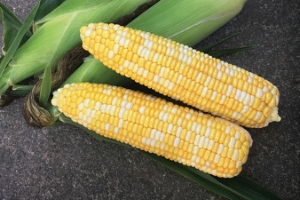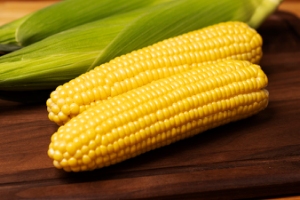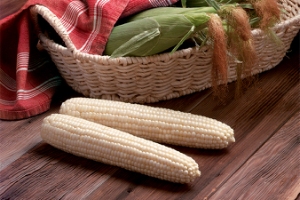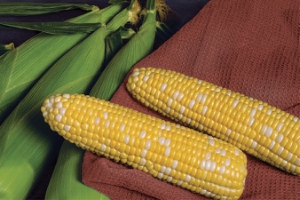
Attribute Plus


Attribute® insect-protected hybrids are sweet corn varieties that have been genetically enhanced to provide strong protection against damage by European corn borers and good control of corn earworms and fall army worms. These hybrids carry a gene that enables them to produce the same insect control protein as Bacillus thuringiensis (Bt) - a naturally occurring soil bacterium that some growers spray on their fields to control these pests. When target insects consume a small amount of plant tissue from an Attribute insect-protected hybrid, the Bt protein binds to their digestive systems causing them to stop feeding and die within 48 hours.
Attribute insect-protected hybrids produce the Bt protein throughout their leaves, silks, stalks and ears throughout their lives, enabling them to provide season-long protection against these potentially devastating insect pests – protection that won’t wash off in the rain or degrade in the sun. The Bt protein is more targeted than other types of insect control, so beneficial insects such as ladybugs and assassin bugs tend to thrive in Attribute sweet corn fields, providing another layer of pest control.
Attribute insect-protected hybrids enable growers to reduce their use of the chemical pesticides they would normally apply to control European corn borers, corn earworms and fall army worms by as much as 50%. The potential benefits of applying chemical pesticides less frequently include: lower input, less drift, less run-off, less frequent need for spray-related worker safety regimens and less plant damage from spray-related machinery.
Additional information on the Attribute products can be found at the following link: http://www.syngenta-us.com/seeds/vegetables/commerical-sweet-corn.
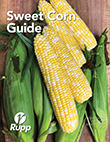
Sweet Corn Guide
The Rupp Seeds Sweet Corn Guide will help both beginner and experienced growers alike maximize their full potential in producing one of the most popular vegetables grown in the United States.
Growing Tips
-
Can be sprayed with glufosinate herbicide.
 Attribute® varieties are resistant to Liberty herbicides. They may be sprayed with conventional corn herbicides as well as Liberty (glufosinate) herbicides. Be sure to read the label and confirm that the chemical you are spraying is 100% glufosinate with no other active ingredients.
Attribute® varieties are resistant to Liberty herbicides. They may be sprayed with conventional corn herbicides as well as Liberty (glufosinate) herbicides. Be sure to read the label and confirm that the chemical you are spraying is 100% glufosinate with no other active ingredients.
- Planting
-
Plant seeds 8 - 12 inches apart on 30 inch rows to achieve optimum yield. Seed depth should be ¾” - 1½” depending on soil conditions, and genetic type. Plant when soil temperature is 60º F plus. Planting in blocks will also help increase uniformity in pollination.
Planting Guidelines - Sweet CornApproximate Seeds per Pound:2,700 - 6,000Seeding Rate per Acre by Weight:4.5 - 6.7 lbsSeeding Rate per Acre in M (1,000):18.2 - 27.3 MSeeding Rate Seeds per 1,000 foot of Row:1,000 - 1,500Seed or Plant Spacing In Row:8 - 12"Seed or Plant Spacing Between Rows:30"Seed or Plant Spacing Depth:.75 - 1.5"Recommended Soil Temperature:60 - 75°FDays to Germination:7 - 10
- Seeding Rate
-
18,000 - 22,000 seeds per acre or one seed every 8 - 12 inches. To achieve this singulation use a finger or air seed delivery system.
- Management
-
Be sure to read the Managing Insects in Sweet Corn page in our catalog for additional information. Scout field every 7 days to check for insect, weed, and disease pressure. For identification of weeds, insects, and diseases, consult your local extension office or go to the Midwest Vegetable Production Guide.
- Isolation
-
For all high quality sweet corn varieties, maintaining an isolation is required to protect the high sugar and flavor characteristics of the sweet corn as cross pollination from other types of sweet corn or from different types of corn will result in starchy kernels.
SE/Synergistic types and SH2/Improved Super Sweet types should be isolated both from each other and from other types of corn including field corn, popcorn and ornamental corn.
An isolation can be achieved either by distance or by a difference in maturity. Preferable isolations would require 700 – 1000 feet distance from other corns, or 10 – 14 days difference in maturity between varieties.
- Relative Maturity
-
Sweet corn maturities are publicized as days to relative maturity. This information comes from supplier data, as well as our trial observations in the Midwest. Prolonged excessive heat or cool temperatures can cause maturity dates to fluctuate to some degree . Monitor your crop through the growing season in order to pick at optimum freshness.
- Harvest
-
Harvest sweet corn when the end kernels of the ear feel developed. Approximately 21 - 25 days after half silk. Sample sweet corn to ensure quality.
- Storage
-
Pre-cool cob temperature to 50ºF. After pre-cooling store at 34ºF and 95% humidity.
